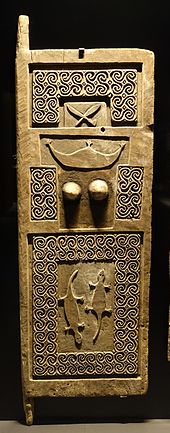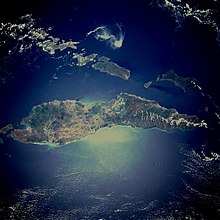The good crocodile

The good crocodile ( tetum Lafaek Diak ) is the native creation myth of the island of Timor . The island is therefore also called the land of the sleeping crocodile .
action
One day a boy found a baby crocodile trying to get into the sea from the lagoon. Because it was very weak, the boy took the little crocodile and carried it to the sea. The crocodile was very grateful and promised the boy to return the favor. It told the boy that it wanted to travel with him. The boy should come to the sea, call it and the crocodile would help him.
After a while, the boy remembered the crocodile's promise and went to the shore of the sea. He called the crocodile three times. When the crocodile appeared, they were both very happy to see each other again. The crocodile told the boy to sit on his back, and the crocodile carried the boy on many, many journeys for many, many years.
But even though the crocodile and the boy were friends, the crocodile was still a crocodile. It felt an irresistible urge to eat the boy. This bothered the crocodile and so it asked other animals for advice. It asked the whale, the tiger, the water buffalo and many other animals and they all said, “The boy was nice to you, you can't eat him.” Finally the crocodile asked the wise monkey. After listening to the story, the monkey cursed the crocodile and disappeared.
The crocodile was ashamed and decided not to eat the boy. Instead, it took the boy back on his back and they traveled together until the crocodile got very old. The crocodile, feeling that it would never be able to repay the boy's kindness, said to the boy: “I will soon die. But my body will form a new land for you and your descendants. "
The crocodile became the island of Timor, which is still in the shape of a crocodile today. The boy had many offspring who inherited from him his kindness, kindness and sense of justice.
Zoological background

The estuarine crocodile is the largest predator that lives on Timor's coasts and in its rivers and lakes. It is the only species of crocodile that also lives in the sea and is native to the entire Southeast Asian island world between the east coast of India and the north coast of Australia . At the Ira Lalaro , East Timor's largest lake, and its rivers, around three hundred specimens live in isolation without access to the sea or other conspecifics. Here they live exclusively in fresh water, nine kilometers from the sea and separated from the coast by the Paitchau mountain range.
The crocodile in everyday life in East Timor
The crocodile is a national symbol of East Timor . While it was still hunted during the Portuguese colonial (until 1975) and Indonesian occupation (1975–1999), it has been under protection in independent East Timor since 2002. It appears in the most varied of forms in everyday life, for example in logos and brands, comic characters, graffiti or as a costume at the Dili carnival.
Protection of the estuarine crocodile has led to an increase in population and an increase in crocodile attacks on humans and pets. CrocBITE, the database of crocodile attacks at Charles Darwin University , has registered 61 fatal and 24 other attacks on people in East Timor since 2007 (as of May 25, 2020). The numbers could be even higher, however, as various communities see the death of a loved one by a crocodile as a disgrace. A crocodile attack is seen as ancestral punishment, which is why many families do not officially report their victims. According to press reports, it is not possible to swim on several beaches because of the crocodile threat.
On December 2, 2015, a saltwater crocodile even swam to the shore in the state capital Dili , directly below the government palace . A large crowd gathered to marvel at the crocodile. It was even fed. The Batalhão de Ordem Pública (BOP) of the East Timorese National Police (PNTL) has three crocodiles named "Aminu" ( German bodyguard , three and a half meters long), "Sparro" ( German sword ) and "Rama" ( German. ) In their main base in Bairro Pite Beret ). The BOP has named three special units after their mascots. The defense forces of East Timor also keep crocodiles in their bases.
In 2010 a Crocodile Task Force was set up from ten men. East Timor received support from the Australian Northern Territory , where they have long experience in dealing with saltwater crocodiles. Captured crocodiles should be housed in a park in Hera . However, traditional leaders opposed the plan. You just have to treat crocodiles and the environment with respect, then there would be no attacks. Local anthropologist Josh Trindade, who advised the task force, said that each and every case involving the removal of a crocodile from its environment must be carefully considered and based on local beliefs. The task force taught the population in rural areas how to recognize crocodile hunting grounds and how to deal with the animals. However, after budget cuts, the unit had to cease operations.
Emblem of the East Timorese government during the UN administration
Mural in Manatuto
Clay crocodile from Manatuto
Modern carving in Maubara
Cultural meaning


For most of Timor’s ethnic groups, the crocodile is considered sacred ( lulik ) . They call the crocodile grandfather (Abo Lafaek) and whenever they cross a river they shout: “Crocodile, I am your grandson - don't eat me!” In the Fataluku , next to the term “sunrise” (vacu hia sukana) and “Sunset” (vacu isinu) , the east “head of the land” (mua cao) and the west “tail of the land” (mua ulafuka) .
The crocodile is a popular symbol in Timor. It is traditionally used on handicrafts, works of art and as carvings or drawings in the holy houses ( tetum Uma Lulik ; Fataluku : lee teinu ). In the traditional representation from a European point of view it often looks more like a lizard . The politician and writer Xanana Gusmão wrote a poem called Grandfather Crocodile .
The crocodile has also found its way into metaphors . This is how the exodus of Timorese refugees during the occupation by Indonesia was called "Leaving the crocodile".
The legends and traditions surrounding the crocodile differ in the different regions of the island. In some places the animals are kept as pets, in other places people prefer to keep their distance from crocodiles as a sacred warning.
If a young girl is kidnapped by a crocodile on a river on the south coast of Timor, the misfortune in the region is explained by the fact that the sins of the village were cleared up by the death. Also on Lake Malai , in the East Timorese community of Bobonaro , there are traditional attempts to explain when people fall prey to crocodiles. If a woman is killed by crocodiles, it is said that the crocodiles have taken a liking to her and wanted to take her as a wife. Killed men are said to have been punished for pride and arrogance.
The historical rulers of the West Timorese Kupang saw themselves as descendants of crocodiles. Therefore, a sacrifice was publicly made to enthrone new rulers in saltwater crocodiles. This consisted of a pig with red bristles and a young girl. The girl was festively dressed, perfumed and decorated with flowers. They were then brought to the bank and tied to a sacred stone in a cave. Then one of the ruler's guardians called the crocodiles, who then killed the girl. The residents of Kupang saw the girl as the bride of the crocodiles. If she wasn't a virgin, it was believed that the crocodiles would bring her back. At other festivities, a newborn girl was consecrated to crocodiles and later married to a priest.
literature
- Sebastian Brackhane et al .: When conservation becomes dangerous: Human-Crocodile conflict in Timor-Leste , 2018.
- Sebastian Brackhane, Yusuke Fukuda, Marcal Gusmao, Flaminio ME Xavier: Habitat Mapping of the Saltwater Crocodile (Crocodylus porosus) in Timor-Leste , 2018.
- Sebastian Brackhane et al .: Crocodile management in Timor-Leste: Drawing upon traditional ecological knowledge and cultural beliefs , 2019.
Web links
Individual evidence
- ^ A b Reconnecting family histories: striving to link communities with Timor Lorosa'e. ( Memento from July 27, 2008 in the Internet Archive )
- ↑ a b Andrew McWilliam: Austronesians in linguistic disguise: Fataluku cultural fusion in East Timor ( Memento of November 7, 2014 in the Internet Archive ) (PDF; 171 kB)
- ↑ ETAN: Legend of East Timor: The Crocodile Story ( English )
- ↑ Universidade de Coimbra: The crocodile that became Timor (English)
- ↑ Mark O'Shea et al. a .: Herpetological Diversity of Timor-Leste Updates and a Review of species distributions. In: Asian Herpetological Research. 2015, 6 (2): pp. 73-131., Accessed on July 17, 2015.
- ↑ a b c d e f g h Vincent Paunovic: Crocodiles: The deadly totems of Timor-Leste , Radio New Zealand, May 3, 2018 , accessed May 3, 2018.
- ↑ CrocBITE - Worldwide Crocodilian Attack Database , accessed May 25, 2020.
- ↑ SAPO Haksolok: Aparecimento do crocodilo em Dili , December 2, 2015 , accessed on December 2, 2015.
- ^ Press Release of Presidency of the Republic: Crocodile Task Force train with the best of the best. May 3, 2012.
- ^ The Dili Weekly: Traditional elders opposed to crocodile management plan , accessed September 4, 2016.
- ^ UN Chronicle - Grandfather Crocodile'-Timor-Leste's Cultural Heritage
- ↑ a b Matthew Libbis BA (Hons) Anthropology: ritual Sacrifice & Symbolism in Timor-Leste , accessed February 18, 2015.
- ^ Margaret JE King: Fishing Rites at Be-Malai, Portuguese Timor , p. 117. In: Records of the South Australian Museum, Adelaide, Sth Aust. : Govt. Printer: From Records of the South Australian Museum , Volume 15, No. 1, October 6, 1965.
- ↑ James George Frazer: The Golden Bough , Cambridge 2012, ISBN 1-108-04731-9 .







